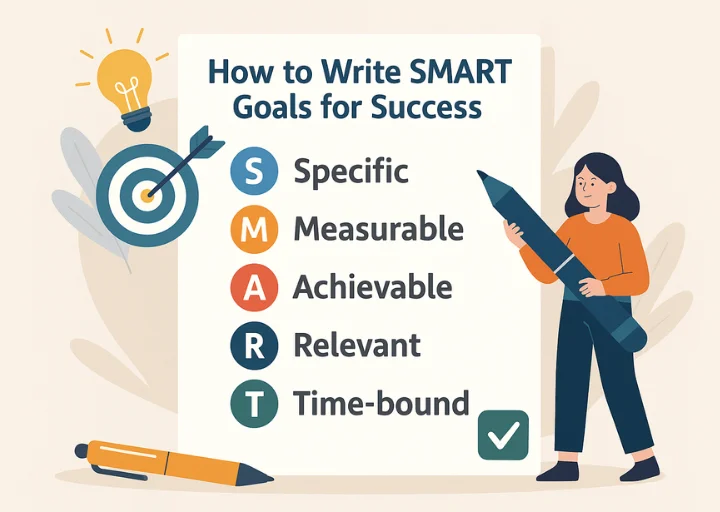Success is more probable when your objectives are clearly defined and realistic.
Meet Rohit, product manager at a mid-size technology company we’ll refer to as Tech Agency Inc. Rohit is charged with boosting activity on the firm’s mobile app.
He is aware that this will have to be a group effort. While his previous experiences have shown that when he tried setting goals across his team, they were going to get lost in the mix. Success was not defined, there was no set method of measuring progress, and the goal ultimately got lost in the background, lost in the end.
This time, Rohit plans to do things differently. He plans to use SMART goals to make a good plan of action and ensure that there is continued progress.
Table of Contents:
1. What are SMART goals?
2. How to write SMART goals
2.1. S: Specific
2.2 M: Measurable
2.3 A: Achievable
2.4 R: Relevant
2.5 T: Time-Bound

What are SMART goals?
SMART is a mnemonic for Specific, Measurable, Achievable, Relevant, and Time-Bound.
By actually defining these five elements for each goal, you improve the chances of achievement within a given time frame. This approach eliminates confusion, forms an open plan, and allows you to keep track of progress and identify any adverse setbacks.
This is what a SMART goal would be:
Our goal is to [quantifiable objective] by [timeframe or deadline]. [Key players or teams] will accomplish this by [steps to be taken]. The achievement of this goal will lead to [expected result or benefit].
How to write SMART goals
We will go through each component of SMART goals with Rohit’s situation as our example.
S: Specific
A goal is optimal when it is clearly defined. Specific objectives give answers to significant questions such as:
- What needs to be done?
- Who is to do it?
- What needs to be done to accomplish the objective?
Asking for answers to these questions helps sharpen your focus and make your intent explicit. Let us examine a sample of a specific goal that Rohit may set:
SPECIFIC
Increase Tech Agency’s mobile app monthly active users via improved app store listing and social media targeted advertising.
M: Measurable
As valuable as specificity is, defining your goals to be measurable makes them more clear and easier to make progress on. It also means you can definitively know when you’ve achieved your goal.
Rohit and his product team want to grow their app’s user base, but what does that growth look like? Is one new user enough? And their marketing strategy on how many platforms will they be marketing?
To add specificity and clarity to the objective, Rohit needs to include concrete measurements that can be quantified and evaluated.
MEASURABLE
Grow Tech Agency’s monthly mobile app active users by 1,000 through app-store optimization and four targeted Facebook, Twitter, Instagram, and LinkedIn campaigns.
A: Achievable
Time for a reality check. Objectives need to be challenging but not so outrageous that they’re discouraging. Ask yourself whether the objective is something your team can realistically accomplish.
Rohit goes back to the plan. With the strength of his team and the workload, it may be too much to campaign on four platforms. In order to keep things manageable, he shortens the scope to three platforms where there is maximum chance of connecting with their target group.
ACHIEVABLE
Increase the monthly users of Tech Agency’s mobile app by 1,000 through optimizing the app-store listing and executing social media campaigns on Facebook, Twitter, and Instagram.
When you’re the one dictating the goals, it’s easier to set them in relation to your team’s capacity. If the goal is being passed on to you from somewhere else, you must inform others of any constraints you have. Even if the goal is being held steady, transparency enables others to see around corners.
R: Relevant
This is where you step back and consider why this goal is worth having. Why does it matter? How is it advancing the bigger mission?
Rohit recognizes that greater app use directly influences customer loyalty, and eventually, revenue. He refines his goal to emphasize this strategic importance.
RELEVANT
Boost monthly Tech Agency’s mobile app users by 1,000 through improvement of app-store listing and execution of targeted ads on Facebook, Twitter, and Instagram. Since users of an app tend to have higher engagement rates, more usage will translate to increased overall profitability.
T: Time-Bound
Timing clarity is vital. All those involved should be cognizant of the target time horizon: when the task will begin, when it ought to conclude, and when it will be evaluated as a success.
By having time constraints, SMART goals stay specific and encourage responsibility. Rohit finishes his objective with a clear time frame.
TIME-BOUND
Boost the monthly usage of Tech Agency’s mobile app by 1,000 in Q1 2022. This shall be achieved by improving the app-store listing and launching targeted campaigns on Facebook, Twitter, and Instagram, starting from February 2022. Since mobile is our primary channel for paid conversions, the increase in app usage will directly translate into growth in sales.
Learning how to create goals using the SMART system provides you with a practical way to achieve success, whether you are striving for a big company goal or a small personal goal.